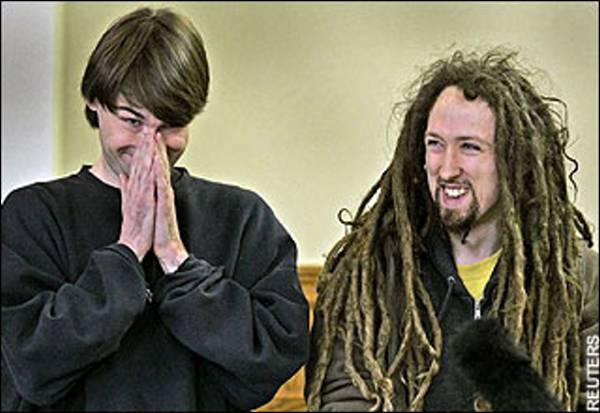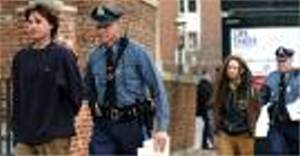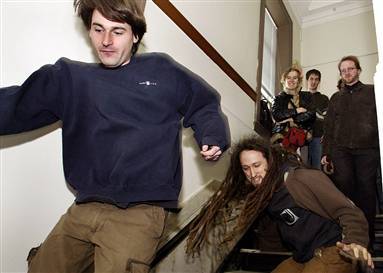
FEBRUARY2007
_____________________________________________________________________
CTHEORY:
THEORY, TECHNOLOGY AND
CULTURE VOL 30,
NOS 1-2
*** Visit
CTHEORY Online: http://www.ctheory.net ***
1000 Days 050
07/02/2007 Editors: Arthur and
Marilouise Kroker
_____________________________________________________________________
Fear and
Loathing in the Bay State
~Dion Dennis~

Prologue
--------
Over the last six years, at midnight, six times per
week, the dadaist fifteen-minute cartoon series,
~Aqua Teen Hunger Force~ chronicles the absurdist
adventures of its three anthropomorphized leads:
Frylock (a goateed McDonaldesque sleeve of French fries),
Master Shake (a self-absorbed generic milk shake
outfitted with a bent pink straw) and Meatwad (a
smallish, speckled, and decidedly unappetizing
specimen). ~Aqua Teen~ is popular with the 18-34 year
old demographic.
With an ~Aqua Teen Hunger Force~ film due for
release in early '07, Cartoon Network's corporate
parent, Turner Broadcasting, hired New York-based
marketing firm, Interference Inc., to produce a viral
marketing campaign in eleven U.S. cities. In late
2006, Interference Inc. hired two young Boston-area
artists, Belorussian immigrant Peter Berdovsky and
Sean Stevens to place 38 LED signs (of one of two
villains of the show, either Ignignokt or Err, defiantly
gesturing with the middle finger) in the Boston
area. By January 29th, all of these quasi
"lite brites" (the ensemble consisted of
printed circuit boards and other easily accessible
electronic components, with LEDs and a pack of
D-Cell batteries to power these 2.5 sq ft. signs)
had been installed around high-traffic sites in the
metroplex.
During the January 31, 2007 rush hour, a transit
employee spotted one of these signs on a supporting
beam of I-93, near Downtown Boston. Mistaking the
"Mooninite" for an explosive device, the
Boston Police Department closed the northbound
lanes of I-93. By the early afternoon, other
"Mooninite" sightings led to two major bridge
closures, and boat traffic on the Charles River was
banned. It wasn't until the late afternoon that the
public knew that these were
part of a benign viral marketing campaign. Turner
issued a press release, and soon after, Berdovsky
and Stevens were arrested.

So this is what it has come to: Two young artists
(their demeanor an echo of 1960s creative
expressiveness), paid a pittance to playfully
market a surrealist cartoon movie starring several
talking base-level consumer commodities, have been
labeled semiotic terrorists and criminals by
official reality. What does this political panic
reflex, played out in the gerontocratic and the
politically correct Commonwealth of Massachusetts,
tell us? [1] What are the object lessons that can
be drawn from this emotive, mediated and
bureaucratic externalization of early 21st Century
nightmares and demons? According to the criminal
statute applied, these crude LED
"Mooninites" that literally flipped Boston
"the Bird" were legally defined as
"infernal machines." [2] Among the eleven
cities targeted by this particular guerilla
marketing campaign, only in Boston were these
innocuous "lite brites" perceived to be objects
of terror. Only in Boston did official reality shut
down major parts of the city, deploy the Bomb
Squad, and make ritualistic arrests and
arraignments. Therefore, the question can, and
should, be asked: What does this say about the
current ~conscience collectif~ in the land of the
Puritans, Kerouac, and Kennedy? What is going on in this
stubborn bastion of a once optimistic
state-centered liberalism, as it reacts to signs
that oddly refract images of a Vietnam-era
collective self? Official and local media reactions
constitute a
classic case of what psychologists call
"hostile attributional syndrome." In this
syndrome, subjects inappropriately react to neutral
stimuli as if such stimuli were signals of real
hostility. Appropriately decoded, these reactions
have significant diagnostic value. As a public
event, the response of official organs displays
complex patterns of displacement and condensation,
as befits such a symbolic event and product. Below
are some (hopefully) heuristic disentanglements of
a couple of these very complex threads.
Puritan Remix
--------------------------
First, we can see the historical and hysterical
echoes of the 17th Century Salem witch trials. The
two artists, the long-haired, bearded Belorussian
immigrant Berdovsky and his sidekick, Stevens, stand
publicly accused of producing, as defined by
Massachusetts General Law, Chapter 266, Section
102, an "infernal machine."
(Etymologically, the term "infernal"
refers to Hell and the
identities and products of the demons of said
residence). So, like Arthur Miller's John Proctor,
they will undoubtedly be asked to "make a
deal" with official reality, to acknowledge their
"infernal"
(demonic) specific intent (as defined by the
statute) and, in doing so, externalize the demons
of the populace as they reaffirm the dominant
symbolic order. [3] Contemporary ritual exorcisms will be
performed in court, press conferences and press
releases, and remixed and expanded by local and 24
hour news media, as they are archived for
subsequent use.
Like the Puritans, such forms of punishment have a
public and semiotic function, through a display of
overt signs of stigma and discredited identity.
Rituals of moral condemnation and public shunning
no longer take the form of the stocks and the wearing of
a Scarlet "A." Rituals of exclusion and
continuous surveillance replace public shaming and
shunning. They take multiple forms, these days:
Electronic monitoring, voter disenfranchisement for
felons, the presence of names on "no fly"
lists, the posting of discrediting billboards
outside of homes as court-ordered punishment, and, in the
case of the most notorious, real-time GPS tracking,
available to a
hyper-vigilant public via Google maps, and so on.
And, there is always the potential for ubiquitous
and sensationalized media attention, given the
insatiable appetite for stories of deviance.
The absurd (and unfounded) criminalization of
Berdovsky and Stevens is part of an ~uber~ moral  tale
with a discernible target: General deterrence, as
rationale and goal. Here, it takes the form of overtly
sending a signal about policing the speech and
conduct of the Millennial Generation; speech and
conduct that is a palpable behavioral and
expressive remix of the deterritorializing ~elan~ of
the 1960s. Injecting a self-policing function
deeper into the psyche of the children and
grandchildren of the Boomers is one use for this
LED scare. "We prohibit unauthorized echoes of
what we did. You play and you express yourself at
your own risk." Certainly this is one of the
covert messages of the Zeitgeist police, newly installed
State's Attorney General, Martha Coakley, as
exemplified by her actions (arrest warrants) and
her February 2, 2007 press release. [4]
tale
with a discernible target: General deterrence, as
rationale and goal. Here, it takes the form of overtly
sending a signal about policing the speech and
conduct of the Millennial Generation; speech and
conduct that is a palpable behavioral and
expressive remix of the deterritorializing ~elan~ of
the 1960s. Injecting a self-policing function
deeper into the psyche of the children and
grandchildren of the Boomers is one use for this
LED scare. "We prohibit unauthorized echoes of
what we did. You play and you express yourself at
your own risk." Certainly this is one of the
covert messages of the Zeitgeist police, newly installed
State's Attorney General, Martha Coakley, as
exemplified by her actions (arrest warrants) and
her February 2, 2007 press release. [4]
Coakley's means and ends are not so very different
than the goal of 17th and 18th Century Puritans:
They, too, intended to deeply inject a
self-policing function into the congregation. Then, the
push was to restrict the psyches and social
expression of women, as well as of those men less
committed to a patriarchal fundamentalist order.
Social, technical, demographic and cultural
transformations over three centuries have
repositioned the Puritan impulse. The rush to an
~ersatz~ criminalization of two young artists
all-too-accurately
exemplifies Richard Ericson's recent (and
plaintive) summary of the pathologies of early 21st
Century life:
[There's] an alarming
trend across Western countries of treating every
imaginable source of harm as a crime... This urge to
criminalize is rooted in neo-liberal political cultures
that are obsessed with
uncertainty... Catastrophic imaginations are fueled,
precautionary logics become pervasive, and extreme
security measures are invoked in frantic efforts to
preempt imagined sources of harm. [5]
Apparently, key points of the local social
imaginary include criminalizing the placement of
child-like and benign "lite brites" in
locations proximate to Massachusetts Bay. While
Ericson's insights constitute a critical element
for understanding the root causes of this
particular event, one other element, I believe, is
required to make fuller sense as to why such
media-fed, institutionally expressed hysteria
occurred in Boston and not in other locations across the
U.S.

The Generational Warfare Strategies of a Greying
Populace
---------------------------------------------------------
This remix of Puritanism and the neo-liberal
imaginary (obsessed with what Ericson dubs
"the myth of certainty and security") is a
necessary but not sufficient set of conditions for
declaring this
peculiar "state of emergency." [6] The
remaining variable is demographic. It pits an
aging, declining and reactive population (the third
or fourth generation descendants of Irish, Italian,
German, and English immigrants) straining to secure
the slipping remnants of a mid-20th Century
state-centered set of expected benefits, against a
more vigorous and adaptable creative subculture
within the Millennial Generation. Not surprisingly,
there's been a steady outflow of educated
Millennials from the Bay State to points South and West,
where a younger, educated demographic is welcomed
and treated with greater public courtesy. [7] The
Bay State response to a benign set
of LED graphics, when compared to how these crudely
drawn Mooninites were viewed in other venues across
the U.S., makes the point unusually clear. [8]
The fear and loathing doled out to Berdovsky and
Stevens is a vivid displacement and condensation of
the fears of a vocal and local demographic
convergence. There's an entire archeology of cultural
ghosts. These "John Proctors" of the
moment, Berdovsky and Stevens,
serve as a projection screen. [9] As icons, the
many ghosts of the collective past merge with a
palpable fear of the present and the future. So
clearly discernible, behind all the self-congratulatory
"politically correct" rhetoric that so
freely and routinely floats across the Bay State,
is a deep distrust, a distrust that damages
spontaneous practices of freedom, practices that
are so necessary for growth.
Notes:
------
[1] "Suspicious objects found throughout
Boston after morning bomb scare," in the
January 31, 2007 online edition of the ~Boston
Globe's~ website, John R. Ellement, Mac Daniel, and
Andrew Ryan, byline.
http://www.boston.com/news/globe/city_region/breaking_news/2007/01/
suspicious_obje_1.html
[2] See "The General Laws of
Massachusetts," Crimes Against Property,
Chapter 266, Section Section 102A1/2, Subsection B,
that legally defines such "infernal
machines" as a constitutive element of the
crime. http://www.mass.gov/legis/laws/mgl/266-102a.5.htm
[3] Miller, Arthur. _The Crucible_. New York:
Dramatists Play Service Inc., 1998.
[4] See Mark Frauenfelder's repost at
BoingBoing.net: "State of Massachusetts
insists on calling ATHF ads 'hoax devices',"
February 2, 2007.
http://www.boingboing.net/2007/02/02/state_of_massachuset.html
[5] Richard V. Ericson. _Crime in an Insecure
World_. Malden, MA. Polity Press. 2007. The excerpt
is from the Introduction on p. 1.
[6] Ericson, p, 219.
[7] "Most Who Left State Don't Plan to
Return," in the May 14, 2006 online edition of
the ~Boston Globe's~ website, Michael Levinson,
byline.
http://www.boston.com/news/local/massachusetts/articles/2006/05/14/
most_who_left_state_dont_plan_to_return/
[8] See these "suspicious objects" on
BoingBoing.net: "Boston Channel photoshops
Mooninite LED signs," Mark Frauenfelder's post, on
January 31, 2007.
http://www.boingboing.net/2007/01/31/boston_channel_photo.html
[9] To see a video of Berdovsky and Stephens,
discussing hairstyles at their initial news
conference, see the Alternet Media site:
"Pranksters Give finger to the Media:"
http://alternet.org/blogs/peek/47507/
--------------------
Dion Dennis is Assistant Professor of Criminal
Justice at Bridgewater State College (MA). He
teaches courses on emerging technology, new forms
of property and equally new forms of social
control; neo-liberalism and 21st Century policing
and corrections; and justice, media and crime.
Dennis' essays have regularly appeared in
_CTHEORY_. His essays and reviews have also appeared in
_Postmodern Culture_, _The Education Policy
Analysis Archives_, _the Academic Exchange
Quarterly_, _Rhizomes_, _Culture and Agriculture_,
_Fast Capitalism_, and _First Monday_, as well as
in new and reprinted form in several print
anthologies.
_____________________________________________________________________
*
* CTHEORY is an international peer-reviewed journal
of theory,
* technology and culture.
Articles, interviews, and key book
* reviews in contemporary
discourse are published weekly as
* well as theorisations of major
"event-scenes" in the
* mediascape.
*
* Editors: Arthur and Marilouise Kroker
*
* Editorial Board: Jean Baudrillard (Paris), Paul
Virilio (Paris),
* Bruce Sterling (Austin), Siegfried
Zielinski (Koeln), Stelarc
* (Melbourne), DJ Spooky [Paul D.
Miller] (NYC), Timothy Murray
* (Ithaca/Cornell), Lynn Hershman
Leeson (San Francisco), Stephen
* Pfohl (Boston), Andrew Ross (NYC),
Andrew Wernick (Peterborough),
* Maurice Charland (Montreal), Gad
Horowitz (Toronto), Shannon Bell
* (Toronto), R.U. Sirius (San
Francisco).
*
* In Memory: Kathy Acker
*
* Editorial Assistant: Ted Hiebert
* WWW Design & Technical Advisor: Spencer
Saunders (CTHEORY.NET)
* WWW Engineer Emeritus: Carl Steadman
_____________________________________________________________________
To view CTHEORY online please visit:
http://www.ctheory.net/
To view CTHEORY MULTIMEDIA online please visit:
http://ctheorymultimedia.cornell.edu/
_____________________________________________________________________
* CTHEORY includes:
*
* 1. Electronic reviews of key books in
contemporary theory.
*
* 2. Electronic articles on theory, technology and
culture.
*
* 3. Event-scenes in politics, culture and the
mediascape.
*
* 4. Interviews with significant theorists,
artists, and writers.
*
* 5. Multimedia theme issues and projects.
*
*
* The Editors would like the thank the University
of Victoria for
* financial and intellectual support of
CTheory. In particular, the
* Editors would like to thank the Dean
of Social Sciences, Dr. C.
* Peter Keller, the Department of
Political Science, the Dean of
* Engineering, Dr. D. Michael Miller
and Dr. Jon Muzio, Department
* of Computer Science.
*
_____________________________________________________________________
*
* (C) Copyright Information:
*
* All articles published in this
journal are protected by
* copyright, which covers the exclusive
rights to reproduce and
* distribute the article. No
material published in this journal
* may be translated, reproduced,
photographed or stored on
* microfilm, in electronic databases,
video disks, etc., without
* first obtaining written permission
from CTheory.
* Email ctheory@uvic.ca for more information.
*
_____________________________________________________________________
*
* Mailing address: CTHEORY, University of Victoria,
PO Box 3050,
* Victoria, BC, Canada, V8W 3P5.
*
* Full text and microform versions are available
from UMI, Ann Arbor,
* Michigan; and Canadian Periodical
Index/Gale Canada, Toronto.
*
* Indexed in: International Political Science
Abstracts/
* Documentation politique
international; Sociological Abstract
* Inc.; Advance Bibliography of
Contents: Political Science and
* Government; Canadian Periodical
Index; Film and Literature Index.
*
_____________________________________________________________________
_______________________________________________
ctheory mailing list
ctheory@lists.uvic.ca
https://lists.uvic.ca/mailman/listinfo/ctheory
